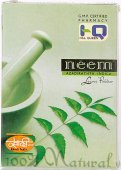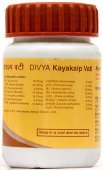Azadirachta indica: 5 definitions
Introduction:
Azadirachta indica means something in Hinduism, Sanskrit, the history of ancient India, biology. If you want to know the exact meaning, history, etymology or English translation of this term then check out the descriptions on this page. Add your comment or reference to a book if you want to contribute to this summary article.
In Hinduism
Ayurveda (science of life)
Cosmetics, Perfumery, Skin care and other Ayurvedic Beauty treatments
Source: Ancient Science of Life: Critical review of Ayurvedic Varṇya herbsAzadirachta indica (Sanskrit: nimba, commonly called neem) is the name of a medicinal plant used in Ayurveda to promote skin care and enhance the beauty of the skin (varṇya).—Azadirachta indica is perceived as a beauty aid in India, neem is particularly prescribed for skin diseases and detoxification of blood. The use of nimba as skin whitening agent is not so popular although purified neem oil and powdered leaves are a major component of at least one widely used facial cream and other cosmetics. But recent studies have suggested its utility as skin whitening agent because the methanolic extract of neem bark has shown significant tyrosinase inhibition activity up to 43.59% whereas leaf showed 10.10% activity. Also, the hydro distilled extract of its heart wood has been reported with significant anti-oxidant activity owing to presence of high phenolic content.
Agriculture (Krishi) and Vrikshayurveda (study of Plant life)
Source: Asian Agri-History: Drumavichitrikaranam—The Ancient Approach to Plant MutagenesisAzadirachta indica (Neem tree) was used in the process of organic plant mutagenesis by ancient Indian agriculturists, which presents a safe technology and methodology regarding organic agriculture, according to treatises (such as the Vrikshayurveda). One such technology was to produce flowers and fruits on other species of plants and trees: The term drumavichitrikaranam (“plant mutagenesis”) obtains its true meaning in the literal sense through this objective. Some of them are described in the Upavanavinoda of Śārṅgadhara: such as to grow Solanum melongena (brinjal) fruits from seeds of Azadirachta indica (neem tree).
Source: Shodhganga: Drumavichitrikarnam—Plant mutagenesis in ancient IndiaAzadirachta indica (denoted by the Sanskrit term Nimba or Picu) is used by certain bio-organical recipes for plant mutagenesis, according to the Vṛkṣāyurveda by Sūrapāla (1000 CE): an encyclopedic work dealing with the study of trees and the principles of ancient Indian agriculture.—Accordingly, “Cocos nucifera is destroyed if fed by water used for cleaning rice. Gossypium herbaceum immediately perishes if fed by water with the leaves of Azadirachta indica [e.g., nimbapatra]”.

Āyurveda (आयुर्वेद, ayurveda) is a branch of Indian science dealing with medicine, herbalism, taxology, anatomy, surgery, alchemy and related topics. Traditional practice of Āyurveda in ancient India dates back to at least the first millenium BC. Literature is commonly written in Sanskrit using various poetic metres.
India history and geography
Source: Suomen Antropologi: Sacred Trees among the Tamil people of South IndiaAzadirachta indica (Neem) is often represented as a “sacred tree” in ancient India.—Trees and Groves were worshiped for their auspiciousness and the numerous benefits derived from them in the form of food, fodder, medicine and firewood.—The shrines of the guardian deities are commonly situated at the entrance of a village. At the core of a shrine there is usually a sacred tree, most often an indigenous species such as a Bodhi (Ficus religiosa), a Banyan (Ficus benghalensis), or a Neem (Azadirachta indica). If the village guardian is male, an image made of stone or clay resides under the tree, sheltered by stone walls and a roof.

The history of India traces the identification of countries, villages, towns and other regions of India, as well as mythology, zoology, royal dynasties, rulers, tribes, local festivities and traditions and regional languages. Ancient India enjoyed religious freedom and encourages the path of Dharma, a concept common to Buddhism, Hinduism, and Jainism.
Biology (plants and animals)
Source: Google Books: CRC World Dictionary (Latin names; Binomial nomenclature)Azadirachta indica A. Juss. is the name of a plant defined in various botanical sources. This page contains potential references in modern medicine, Ayurveda, and other local traditions or folk medicine. It has the following synonyms: Antelaea azadirachta (L.) Adelb., Melia azadirachta L., Melia indica Brandis, Melia indica (A. Juss.) Brandis.
References regarding Azadirachta indica A. Juss. for further research on medicinal uses or toxicity:
· Species Plantarum (1753)
· Mém. Mus. Hist. Nat. (1830)
· Transactions of the Linnean Society of London (1835)
· For. Flora Indica, or ‘Descriptions of Indian Plants’ (1874)
· Blumea (1948)
· Journal of Ethnopharmacology (1981)
· Journal of Cytology and Genetics (1984)
· Journal of Ethnopharmacology (1987)
· Journal of Cytology and Genetics (1988)
· Journal of Ethnopharmacology (1995)
· Afr. J. Health Sci. (1995)
· Journal of Ethnopharmacology (2002)
· Journal of Economic and Taxonomic Botany (2003)
· Journal of Ethnopharmacology (2003)
· Ceiba (2003)
· Journal of Ethnopharmacology (2004)
· Journal of Ethnopharmacology (2005)
· Journal of Ethnopharmacology (2005)
· Journal of Ethnopharmacology (2006)
· African Journal of Traditional, African Journal of Traditional, Complementary and Alternative Medicines (2006)
· International Journal of Dermatology (2007)
· Journal of Ethnopharmacology (2007)

This sections includes definitions from the five kingdoms of living things: Animals, Plants, Fungi, Protists and Monera. It will include both the official binomial nomenclature (scientific names usually in Latin) as well as regional spellings and variants.
See also (Relevant definitions)
Partial matches: Azadirachta.
Full-text (+332): Nimba, Pakvakrit, Kakaphala, Picumanda, Pancanimba, Limba, Prabhadra, Margosa, Neem, Picumarda, Paribhadra, Aricu, Neeb, Neempan, Arunati, Atipam, Civamatukamaram, Kiruminacamaram, Kosaram, Balantanimba.
Relevant text
Search found 11 books and stories containing Azadirachta indica; (plurals include: Azadirachta indicas). You can also click to the full overview containing English textual excerpts. Below are direct links for the most relevant articles:
Bhesajjakkhandhaka (Chapter on Medicine) (by Hin-tak Sik)
Medicines (c): Leaves (Paṇṇa/Patra) < [Chapter 4 - Medicinal Substances in the Chapter on Medicine]
Medicines (g): Decoctions/Astringent Medicines (Kasāva/Kaṣāya) < [Chapter 4 - Medicinal Substances in the Chapter on Medicine]
Medicines (d): Flowers (Puṣpa) < [Chapter 4 - Medicinal Substances in the Chapter on Medicine]
Manasara (English translation) (by Prasanna Kumar Acharya)
Chapter 4 - The Selection of Site (bhūmi-saṃgraha)
Chapter 5 - The examination of soil (bhūparīkṣā)
Brihat Samhita (by N. Chidambaram Iyer)
Pallava period (Social and Cultural History) (by S. Krishnamurthy)
Topography, Geography and Geology of the Region (Tondaimandalam) < [Chapter 1 - Introduction]
Matangalila and Hastyayurveda (study) (by Chandrima Das)
Kautilya Arthashastra (by R. Shamasastry)
Chapter 15 - The Superintendent of Store-house < [Book 2 - The duties of Government Superintendents]
Related products
(+32 more products available)





